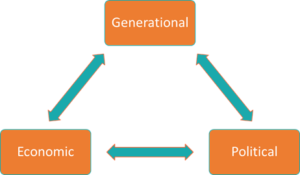Segmentation is crucial in transforming survey data into actionable insights for universities and colleges. Proper segmentation analysis empowers institutions to tailor programs and communications to different cohorts, ensuring relevance and motivation for each group.
The relationship between alumni and their alma mater is profoundly influenced by three key factors: Generational Characteristics, Political Issues surfacing during their time at the institution, and Economic Circumstances confronting them as they enter the job market.
While many researchers focus on generational characteristics, it became evident through extensive alumni research that more is needed. Universities and colleges, acting as sponges and echo chambers of political discourse, shape the experiences of graduates. Moreover, economic conditions during graduation significantly impact alumni sentiments. For instance, graduates in 1995, during a booming economy, had different perspectives than those in 2009 amidst a financial crisis.
PEG has developed Eras of Graduation in alumni research to capture these influences comprehensively:
Woodstock/Vietnam and Prior: Graduated Before 1974
Post-Watergate: Graduated from 1974 to 1980
Yuppie/End of Cold War: Graduated 1981 to 1993
Electronic Revolution/Dot-Com: Graduated from 1994 to 2000
Post-9/11: Graduated from 2001 to 2008
Post-Great Recession: Graduated After 2008
Understanding these eras is vital for effective segmentation. Looking at overall averages can be misleading. For example, analyzing alumni responses on the importance and effectiveness of alma mater communications reveals nuanced insights — the variance between importance and performance highlights where alumni expectations are met or exceeded.
Segmenting this data by era uncovers unique trends. Older alumni generally express satisfaction with communications, while more recent graduates, besides their interest in the magazine, exhibit dissatisfaction. This underscores the importance of segmentation. Recent graduates, despite not attending events, express a desire for more. This challenges traditional event metrics, suggesting that younger alumni perceive events as valuable, regardless of attendance.
Recommendations based on this analysis include reevaluating invitation policies, especially for events not geographically close, and communicating the value of events to all alumni, particularly younger ones.
Insights about alumni preferences hold value when translated into action. Utilizing segmentation analysis is a strategic approach for universities and colleges to implement these insights effectively.
